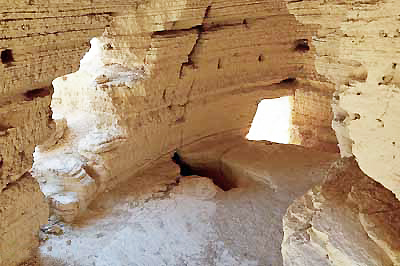
Bible, History, Archaeology
Bible,
History,
Archaeology
The oldest copy of the
Ten Commandments,
in Qumran
The discovery at ‛Aïn Feshka
Between November 1946 and spring 1947, Muhammed edh-Dhib, his cousin Jum'a Muhammed and Khalil Musaun 1, shepherds from the Ta'amireh clan, a Bedouin tribe living on the north-western shores of the Dead Sea, fortuitously discovered priceless manuscripts in a cave perched on a hillside in the Judah desert, near the archaeological site of Khirbet Qumran, about a kilometer from the Dead Sea.
Having proposed these seven parchments to various potential buyers, from antique dealers to religious leaders, the latter underestimated the importance of these documents.
Image opposite: John C. Trever (1916 -2006) was a biblical scholar and archaeologist. He was involved in the discovery of the Dead Sea Scrolls. He became the first American scientist to see fragments of the Dead Sea Scrolls in the spring of 1948 and to photograph them. Public domain.
Between 1947 and 1956, eleven caves were excavated, unearthing numerous manuscripts, and more recently, in February 2017, a twelfth cave, unfortunately already looted in the 1950s, in which all that was found was an unwritten manuscript, broken pottery and abandoned picks.
1. Ultimately, the real identity of the young shepherd is unknown, and several Bedouins have claimed to be the real el-Dhib, known as «the wolf». Moreover, some accounts of the discovery speak of three young Bedouins who found the famous manuscripts.
A view of some of the caves where the Qumran scrolls were discovered. © Alefbet 1082981615.
The current situation
Due to the poor condition of some of the scrolls, researchers have not yet translated all the texts. The texts can be divided into three groups:
- Approximately 30 % are texts from the Second Temple period (Temple of Herod the Great) that were ultimately not accepted into the Hebrew Bible, such as the Book of Enoch, the Book of Jubilees, the Book of Tobit, the Wisdom of Sirach, the Psalms 152-155, etc.
- The remainder (around 30 %) are manuscripts of unknown documents that shed light on the rules and beliefs of a particular group (Essenes) or groups within Judaism, such as the Discipline Manual (now called Community rule), a Habaquq's comment, Le War Scroll (more precisely called the Settlement of the War between the Sons of Light and the Sons of Darkness), etc.
Image above: Repair of a Dead Sea manuscript © D.R.
«These manuscripts shed new light on the sacred texts of Judaism, the choices made in the genesis of the biblical canon and the terrain in which Christianity developed» (Émile Puech).
To date, of the approximately 100,000 fragments discovered, some 980 manuscripts have been dated from the 3rd century BC to 68/70 AD, the date of the siege of Jerusalem and the destruction of its Temple by the Romans.
A view of cave no. 4, where some 90 % of the Dead Sea Scrolls were unearthed. It was in this cave that one of the Deuteronomic manuscripts containing the oldest copy of the Ten Commandments (Words) was discovered. © Sean Pavone. 96106568.
Cave n°4
It was discovered in 1952 by Father Roland de Vaux, director of the French Biblical and Archaeological School in Jerusalem. It was in this cave that 90 % of the Dead Sea Scrolls were unearthed. Biblical scholars noted that several of the scrolls mentioned passages from the Book of Genesis. Deuteronomy. One manuscript in particular (4QT41) attracted the attention of biblical scholars. Deuteronomy of which the oldest complete copy known to this day from the Ten Commandments (5, 14-19). Indeed, epigraphic and carbon-14 analysis initially confirmed that this manuscript probably dated from several decades BC (Herodian period).
The manuscript containing the oldest copy of the Ten Commandments from the book of Deuteronomy, during its presentation. Israel Museum, Jerusalem.
Description

Image opposite: the interior of cave no. 4. Todd Bolen.
Although the scroll must originally have been larger, the unusual order of the texts suggests that it was probably not a normal biblical scroll and contained only extracts from the Deuteronomy, perhaps for liturgical purposes.
The text of the Decalogue has been modified in certain places to bring it into harmony with the parallel version of the Book of the Lord.’Exodus. Finally, a peculiarity in this manuscript is the addition of the institution of the Sabbath from the version of the book of the’Exodus (Exodus 20:10). This one is quite different in its Hebrew form.
More precise dating

Image opposite: an infrared photograph of the manuscript. © Israel Museum, Jerusalem.
The manuscript is rarely exhibited due to its age and fragility, even at the Shrine of the Book, Israel Museum. The parchment has darkened over time, tinted a yellowish brown, and ink marks that were once black have turned gray. Infrared photography was needed to bring out the contrast of the ink, which had begun to fade over time.
 Conclusion
Conclusion
For this manuscript with its version of the Ten Commandments as for the complete manuscript of the prophet Isaiah (or Isaiah) unearthed in the first cave, one can only admire and be impressed by the meticulous care taken by the Soferim (Hebrew: סופרים scribes) who made the copies and passed them on to subsequent generations. For a long time, in view of the centuries that have passed, some have claimed that it was impossible for the original texts of the Holy Scriptures to reach us unaltered.
Image opposite: A Yemeni scribe, early 20th century, copying a Torah text. Library of Congress, Washington, USA.
On the contrary, these two manuscripts and so many others show us that they conform to the versions of the Hebrew Bibles present. This «miracle» reminds us of the words of the Lord addressed to the prophet Jeremiah «...You have seen well; for I have kept my word to perform it» (Jérémie 1,12).




 Conclusion
Conclusion